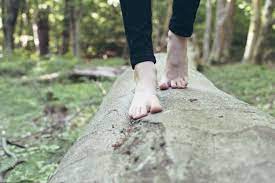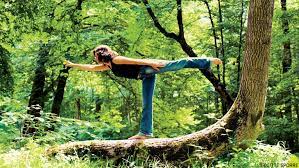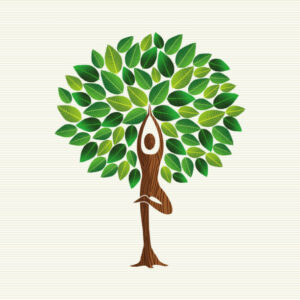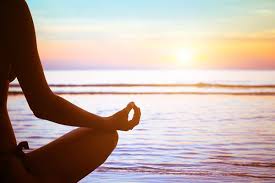You, me and everybody have an innate need to get back to nature. In times gone by. human lives were at one with nature. We planted and harvested our food by the seasons. In summer we moved our bodies and spent hours outdoors. In winter we rested, contemplated, dreamt and definitely got more sleep. Every aspect of our lives was dependent on nature – food, medicine, healing, ritual, survival.

Now in our modern life we have electricity, vehicles and buildings which see us spend a great deal of time detached from nature. It’s possible that if you live in a city you might awake in a multi-storeyed building and not be able to physically touch the earth, get in a vehicle to drive to work, sit in an air-conditioned building all day and get back in your car to drive back to your home. Where in this picture have you connected to the earth? It’s not a criticism, it’s something to ponder.
Whether you’re aware of it or not we all have a deep yearning for nature. Being in nature is to ‘come home’. To be grounded, present, alive, grateful. To be simultaneously enlivened & energised yet calm and peaceful.

Did you know that Yoga poses are named from an aspect of nature?
- Vrksasana – Tree Pose
- Ardha–Baddha Konasana – Butterfly Pose
- Bhujangasana – Cobra Pose
- Tadasana – Mountain Pose

To name just a few. Ancient Yogis knew the power of nature when they named each asana. Each posture was named in reverence to that aspect of nature and as an invitation for the yogin to embody the qualities of nature.
Every animal, plant, mountain and river has a sacred gift for humans. When we come into Tadasana – Mountain Pose we call in the strength, the sovereignty, the power of the mountain. When we practice Garudasana – Eagle Pose we embody the supreme focus, strength and freedom of the eagle. Yoga poses named after an aspect of nature invite us to reconnect not only with nature but with aspects of our soul that we may not acknowledge in our frenetic modern life.

I’m all about the holistic experience of Yoga; going deep. Not just mechanically flinging your limbs around but receiving the true riches from the experience. When practiced consciously Yoga can be a great way to reconnect with nature. There are several ways to do this –
Embody the symbolism of the posture. As I’ve indicated above, each pose is named after nature so when in your posture embody those qualities of nature.

Take your practice outdoors. If you can practice Yoga outside as often as possible. Breathe in the fresh air, feel the space around you, the earth beneath you. Notice the feeling of the air on the skin, the smell of nature, the movement of birds, bees, insects. Most of the year-round my personal practice is outdoors. It is only in the depths of winter or if it’s really raining that I come indoors. My practice is enriched by being in nature. I could write a whole blog just on this!

Use a natural mat – this is so important on many levels. You may not be aware that most of the Yoga mats that people lie on, have their heads close to and limbs scattered all over are made from toxic chemicals. To put it frankly, they are gross! Why would you practice such a beautiful, holistic, nourishing art such as Yoga on a synthetic, chemical-laden, germ-holding piece of material? And no, I’m not just saying this as a sales spin because I stock natural mats. I’m saying this because a few years ago when I had my face down on my mat and I got a woof of the synthetic smell I had this epiphany that I would no longer have my body constantly being exposed to such yuckiness and I began to research natural mats. I vowed then that I would go ‘au la natural’ on the mat front!

Another positive to using a natural mat is that you get to ‘earth’ or ground yourself at the same time. You may or may not have heard of the ‘earthing’ movement? I first read the book about 10 years ago and it was one of the reasons that I committed to practicing Yoga outdoors as much as I could. On a basic level, there are many benefits to connecting your body to the earth including improved sleep, pain relief, reduced inflammation, stress reduction, and so on. Ancient peoples knew this. Yogins knew this. We’ve just forgotten in our modern life. There is now modern research that proves the many benefits associated with earthing which simply means to have part of your body touching the earth (e.g. practicing yoga in barefoot).

When you practice Yoga on a natural mat you still receive the benefits of the earth. On a synthetic mat, the earth energy is blocked.
On a personal level I know I feel better from being outdoors. I need to breathe in fresh air, see the beauty of nature, feel her essence and lifeforce in order to maintain my own wellbeing. Practicing Yoga outdoors on a natural mat allows me to be at one with nature daily and receive her many gifts.

So, my challenges to you are –
- Consider using a natural Yoga mat. Even if you only come to class once a week for most of the year that is a lot of hours of exposure to synthetic materials. The investment in a natural mat is well worth it.
- Consider taking your Yoga practice outdoors. As much as possible get outside and receive a ‘2 for 1’ deal – the goodness of yoga and the goodness of nature!
